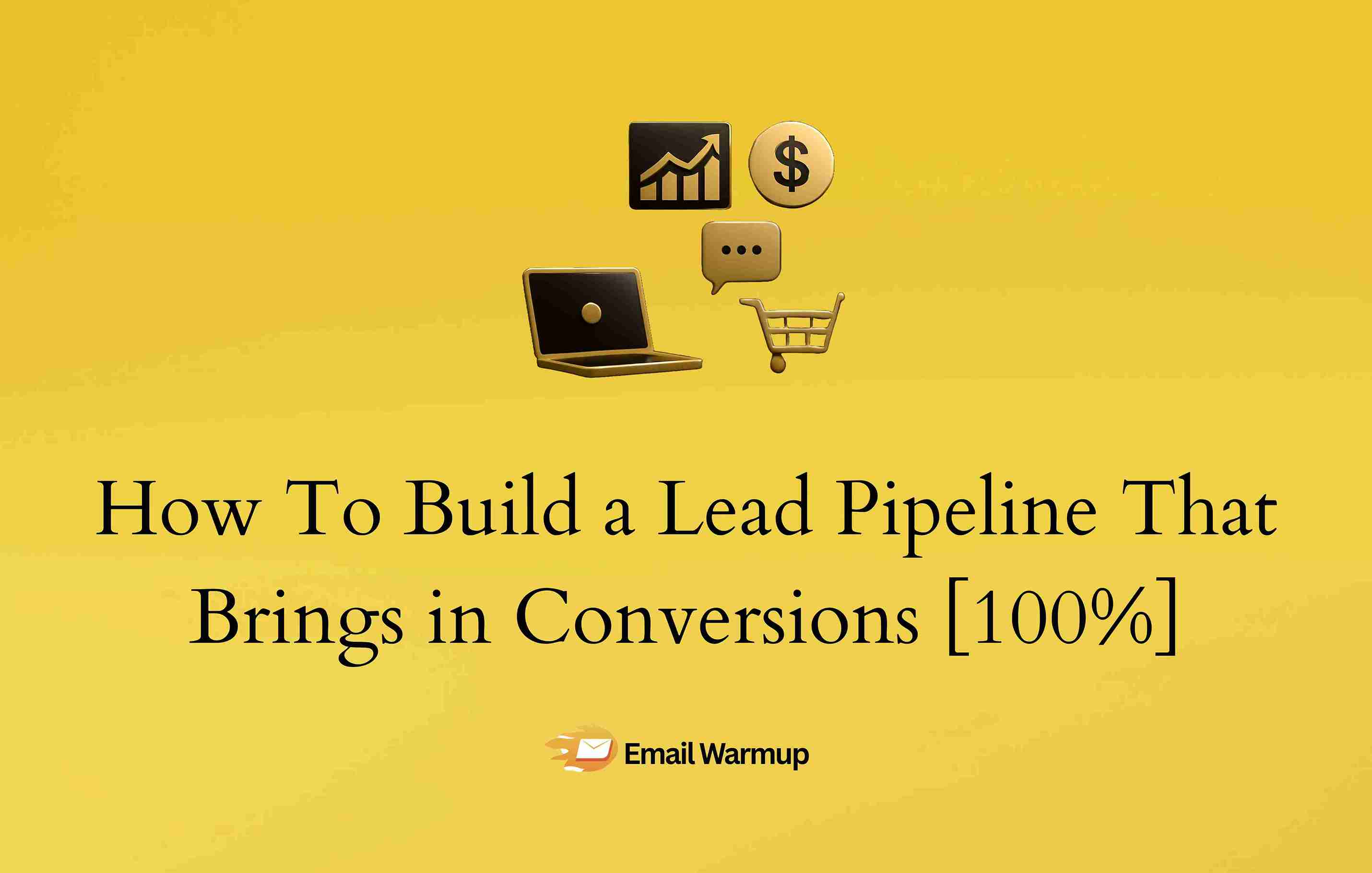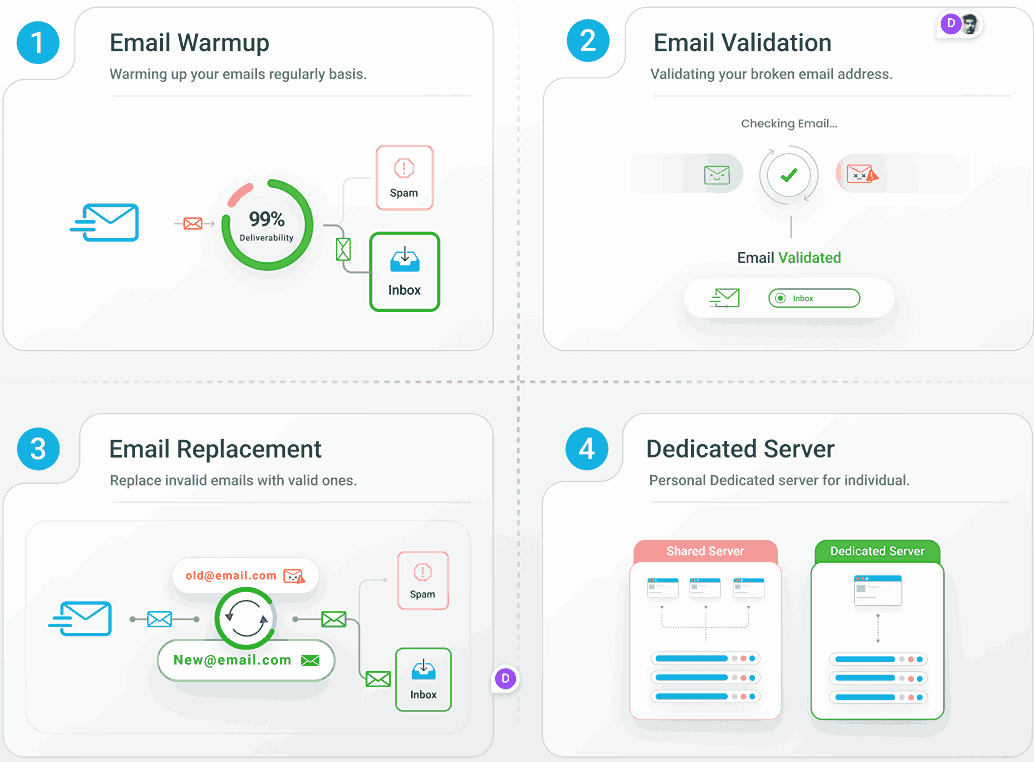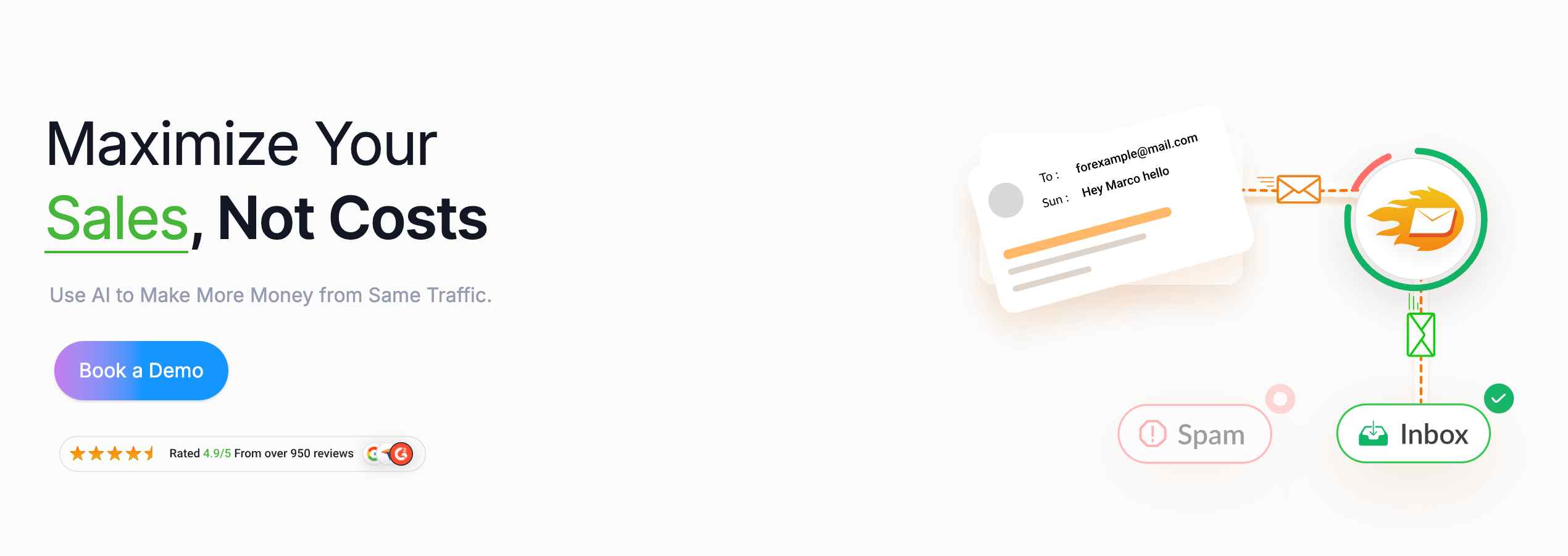
You’re not short on leads — you’re short on structure.
Most businesses bleed potential customers. Not because they lack traffic or interest. Because they have no system to guide those leads into sales. There’s no map, no milestones, and no momentum.
A lead pipeline is your framework that turns strangers into paying customers consistently.
As a lead-gen specialist and email deliverability consultant who has helped hundreds of businesses turn clicks into customers, I’ve prepped this guide to answer:
- What is a lead pipeline
- Difference between sales pipeline & lead pipeline
- Core stages and how to build a strong lead pipeline
- The benefits of having a lead pipeline in your business
Let’s dive in already.
A word of advice
You can build a lead pipeline, but to take it to the next level, you need something like EmailWarmup.com by your side.

EmailWarmup.com seamlessly integrates with your lead pipeline, ensuring no lead is left behind and that your team can focus on closing high-value opportunities, offering:
Find hidden visitors
EmailWarmup.com lets you identify website visitors who bounce away without filling out the form.
Automated multi-channel follow-ups
It ensures no prospect is ever left behind, across calls, texts, and emails.
AI appointment setter
No matter the time or day, if someone fills your contact form, EmailWarmup.com calls (with AI) on your behalf, takes all the details, and schedules an appointment before your competitor does.
Leads sent straight to your CRM
Once we have the first contact, EmailWarmup.com sends all the leads, along with call recordings and summaries, straight to your CRM.
Impressive, isn’t it? You can see it with a free trial (no strings attached)
What exactly is a lead pipeline?
A lead pipeline is the structured path your potential customers follow from first contact to conversion. Each stop is a critical checkpoint in your buyer’s decision process.
Instead of randomly chasing opportunities, you’re guiding each lead through deliberate stages:
- Qualification
- Engagement
- Proposal
- Closing
A sales pipeline tracks opportunities and deals already in motion. Your lead pipeline focuses on the early-stage journey. It’s about turning interest into intent. Your pipeline isn’t just about what your CRM shows. It reflects how well your team moves leads along the path.
A healthy lead pipeline helps you:
- Track touchpoints that matter
- Uncover bottlenecks before they kill deals
- Optimize each interaction along the customer journey
Why do people confuse sales pipelines with lead pipelines?
The terminology gets messy because these concepts overlap, but understanding the differences saves you from building the wrong system.
Lead Pipeline vs Sales Pipeline
Lead pipeline tracks how raw leads become sales-ready. Sales pipeline kicks in once leads are qualified. Now they’re being pitched, followed up, and moved closer to a deal.
Sales Funnel
The sales funnel focuses on the customer’s actions, not your internal processes. This helps you diagnose drop-offs and content gaps at each level.
Sales Flywheel
Unlike the funnel, the flywheel keeps spinning through retention, loyalty, and referrals. It’s built around the idea that great service equals better marketing.
What are the real benefits of a lead pipeline that converts?
When you’re building a lead pipeline, you are discovering the hidden revenue in your sales process. Here’s what a high-performing lead pipeline delivers:
- Pipeline visibility
- Easy forecasting
- Less wasted effort
- Faster sales cycles
- Higher conversion rates
- Better cooperation with marketing
What are the core stages of a lead pipeline?
A strong lead pipeline is built on a series of clear, repeatable stages. These pipeline stages help you move leads from cold to closed, without losing momentum or missing opportunities.
1. Prospecting
This is where it all begins. You’re identifying potential buyers through channels like cold outreach, ads, SEO, referrals, or lead databases.
2. Lead Qualification
Once you’ve captured a lead, the next step is to figure out if they’re worth pursuing. This means checking fit, intent, budget, authority, and timeline.
3. Sales Call or Demo
Here’s where sales reps earn their keep. This is the discovery phase. They understand the lead’s pain points, introduce your solution, and build rapport.
4. Proposal
Once you’ve confirmed fit, it’s time to outline pricing, scope, and next steps in a clear, customized proposal.
5. Negotiation
Now you’re dealing with objections, fine-tuning details, and managing expectations. Don’t treat this as friction — it’s a commitment checkpoint.
6. Close
This is where the deal is signed, the payment is processed, and your lead officially becomes a customer. Also, closing doesn’t mean the pipeline ends.
7. Post-Sale Nurture
The most overlooked stage. Staying engaged after the sale increases lifetime value and fuels referrals. This is where follow-up pays long-term dividends.
How do you build a lead pipeline from scratch?
Building a pipeline that actually converts requires methodical planning and execution. Here’s your step-by-step roadmap.
1. Identify Your Ideal Customer Profile (ICP)
Before you can move leads through a pipeline, you need to know who belongs in it. Define your buyers (their industry, company size, pain points, and decision-making process).
Create detailed buyer personas that include:
- Pain points and challenges
- Buying triggers and motivations
- Demographics and firmographics
- Budget ranges and authority levels
- Preferred communication channels
- Decision-making process and timeline
2. Map Your Customer Journey
Understanding how your customers actually buy helps you design a pipeline that mirrors their natural process. Most businesses skip this step and wonder why their pipeline feels forced.
Research your customer’s journey by:
- Analyzing your sales data for common patterns
- Identifying key decision points and potential objections
- Mapping out all touchpoints from awareness to purchase
- Interviewing recent customers about their buying process
3. Define Your Pipeline Stages
Map your sales process into clear, actionable stages (like the ones in the previous section). For each stage, define what needs to happen before a lead moves forward.
Each stage should have:
- Success metrics
- Expected timeline
- Specific actions required
- Clear entry and exit criteria
- Responsible team members
4. Assign Responsibilities to Each Stage
Be clear with the following questions:
- Who owns which part?
- Is your SDR team handling qualification?
- Is marketing responsible for prospecting?
Create a RACI matrix (Responsible, Accountable, Consulted, Informed) for each pipeline stage to eliminate confusion and ensure accountability.
5. Define Activities and Exit Criteria
Every stage should come with required actions (like booking a call or sending a proposal) and clear outcomes. If you can’t define it, you can’t measure it.
Document:
- Timeline expectations
- Required activities for each stage
- Handoff procedures between teams
- Minimum information needed to advance
6. Set Up Lead Scoring
Not all leads are created equal. Implement a scoring system that helps you prioritize your efforts on the most promising prospects.
Score leads based on:
- Budget and timeline indicators
- Demographic fit (company size, industry, role)
- Explicit interest (demo requests, pricing inquiries)
- Behavioral signals (website visits, content downloads, email engagement)
7. Create Standard Operating Procedures
Document your process so it’s repeatable and trainable. This includes call scripts, email templates, qualification questions, and objection handling frameworks.
8. Set Up Tracking with CRM
Use CRM software to log every touchpoint. Make sure you track email opens, call outcomes, and proposal views. EmailWarmup.com integrates lead identification and CRM syncing for full visibility from prospect to pipeline.
9. Implement Automation Where Possible
Automate repetitive tasks like follow-up emails, lead scoring updates, and task assignments. This frees up your team to focus on high-value activities like relationship building and closing deals.
10. Review, Refine, and Recycle
Pipelines are never perfect from Day 1. Set weekly reviews to see where leads drop off and what stages clog. Constant optimization equals constant conversions.
What Tools Do You Need to Track and Optimize Your Pipeline?
You can’t optimize what you don’t track — and a lead pipeline without the right tools is just guesswork. These tools help you manage, automate, and scale every step.
CRM Software
These are the backbone of your pipeline. Tools like HubSpot, Pipedrive, or Salesforce help log lead data, track movement, and centralize communication.
Lead Scoring and Automation
Use platforms like Lemlist, Mailshake, or ActiveCampaign to score and prioritize leads automatically based on actions they take.
Pipeline Dashboards
Gain real-time pipeline visibility with analytics tools that show deal stages, drop-offs, and velocity metrics. Most modern CRMs include these, or integrate with Google Data Studio or RevOps tools.
Lead Generation and Deliverability Tools
Seamlessly track and nurture leads with email warmup, AI-driven qualification, and 24/7 follow-up. EmailWarmup.com also identifies site visitors and pushes data straight to your CRM for instant action.
Communication Tools
Implement tools for consistent communication across channels:
- Video messaging platforms
- Phone and SMS automation
- Email sequences and templates
- Social media management tools
Data Analytics and Reporting
Track performance with tools that provide insights into:
- Pipeline velocity and conversion rates
- Lead source performance
- Sales team productivity
- Revenue forecasting
How Do You Track Lead Pipeline Performance?
If you’re not tracking the right pipeline metrics, you’re flying blind. These numbers show where leads get stuck, where reps shine, and how well your lead pipeline is performing overall.
| Metric | What It Tells You | Target Range |
| Conversion Rate | % of leads that become customers | 20–30% (B2B avg) |
| Sales Velocity | How fast deals move through the pipeline | Depends on deal size |
| Lead Age | How long leads sit in a stage | <14 days per stage |
| Pipeline Coverage | Total value of deals vs sales target | 3–4× quota |
| Qualified Lead Rate | % of leads meeting qualification criteria | 40–60% |
| Follow-Up Touches | Average # of touchpoints per lead | 5–7 |
| Average Deal Size | Revenue per closed deal | Varies by product |
| Drop-Off Rate | % of leads that leave the pipeline | <50% at early stages |
What to Watch For:
If lead age is climbing, you’re not following up fast enough. Low conversion rate? Revisit your proposal and closing strategy. Stagnant pipeline coverage? You need more qualified leads — fast.
Use tools like EmailWarmup.com or your CRM’s dashboard to track pipeline health in real-time.
Advanced Metrics to Consider
Beyond basic metrics, track these advanced indicators:
- Lead-to-opportunity conversion rate by source
- Customer acquisition cost (CAC) by channel
- Win rate by lead source and sales rep
- Average time in each pipeline stage
- Lifetime value (LTV) to CAC ratio
What Mistakes Should You Avoid While Building a Lead Pipeline?
A lead pipeline is a living system. And like any system, the wrong moves can quietly kill conversions.
Here are the biggest pitfalls to avoid:
Treating All Leads the Same
Without lead scoring or qualification, you’re giving cold leads the same attention as hot ones. That’s a fast track to burnout and bad results.
Segment your leads by:
- Fit with your ICP
- Engagement level
- Source and quality
- Buying stage and timeline
Skipping Defined Pipeline Stages
Trying to “wing it” without clear stages means no repeatable sales process. If you can’t map it, you can’t improve it.
Failing to Follow Up Consistently
80% of deals require multiple touches, but many reps quit after the first email. No follow-up equals no close.
Create a systematic follow-up process that includes:
- Multiple communication channels
- Value-added content in each touchpoint
- Clear timelines and escalation procedures
- Automated sequences for different lead types
For a full strategy, see our guide to cold email follow up.
Overloading Reps with Admin
If your salespeople are updating spreadsheets instead of talking to prospects, your pipeline is a parking lot — not a highway.
Ignoring Metrics
If you’re not measuring conversion rates, deal age, or drop-off points, your pipeline may look full but be full of ghosts.
Clinging to Dead Leads
A lead that’s been unresponsive for 60+ days is likely not coming back. Don’t let wishful thinking cloud your lead management.
Implement a clear process for:
- Defining “dead” leads
- Re-engagement campaigns
- Lead recycling procedures
- Database cleanup schedules
No Cooperation Between Sales and Marketing
If marketing hands over leads that sales can’t use, the entire sales process breaks down before it starts.
Establish service level agreements (SLAs) that define:
- LHandoff procedures
- ead qualification criteria
- Response time expectations
- Feedback loops for lead quality
How Do You Handle Lead Nurturing Throughout Your Pipeline?
Lead nurturing is the bridge between initial interest and purchase readiness. Most leads aren’t ready to buy immediately, so you need systematic ways to stay top-of-mind and provide value.
Content-Based Nurturing
Create valuable content for each pipeline stage:
- Educational content for early-stage leads
- Case studies and social proof for middle-stage leads
- Pricing and implementation guides for late-stage leads
Multi-Channel Approach
Don’t rely on email alone. Effective nurturing uses:
- Retargeting ads
- Email sequences
- Personal outreach
- Educational webinars
- Social media engagement
Timing and Frequency
Balance staying top-of-mind with avoiding annoyance:
- Lower-value leads: Automated sequences with less frequency
- High-value leads: More frequent, personalized touchpoints
- Adjust based on engagement levels and feedback
What Role Does Lead Qualification Play in Your Pipeline?
Lead qualification is the gatekeeper of your pipeline. Poor qualification wastes time on unwinnable deals while missing real opportunities.
The BANT Framework
Budget, Authority, Need, Timeline — the classic qualification framework still works:
- Authority: Are you talking to the decision-maker?
- Need: Do they have a problem you can solve?
- Timeline: When do they need a solution?
- Budget: Can they afford your solution?
Modern Qualification Approaches
Consider frameworks like MEDDIC or SPICED that account for modern buying behaviors:
- Risk-averse buyers
- Longer sales cycles
- Multiple decision-makers
- Committee-based decisions
Qualification Questions
Prepare specific questions for each qualification criterion:
- “What’s driving this initiative?”
- “Who else is involved in this decision?”
- “What’s your timeline for implementation?”
- “What happens if you don’t solve this problem?”
How Do You Optimize Your Pipeline for Different Lead Sources?
Different lead sources require different approaches. A referral needs different handling than a cold lead from advertising.
Referral Leads
These typically convert faster and at higher rates:
- Expedited qualification process
- Leverage the referring relationship
- Focus on maintaining trust
- Higher-touch approach
Inbound Marketing Leads
These leads found you, so they’re already interested:
- Quick response time is critical
- Understand their content consumption history
- Tailor messaging to their demonstrated interests
- Progressive profiling to gather more information
Cold Outreach Leads
These require more nurturing and trust-building:
- Longer nurture sequences
- Social proof and credibility building
- Focus on education and value delivery
- Multiple touchpoints before qualification
Paid Advertising Leads
These can be hit-or-miss depending on campaign quality:
- Align messaging with ad promises
- Track source performance closely
- Optimize campaigns based on conversion data
- Immediate qualification to separate tire-kickers
Why You’re Losing Sales — and How to Fix It
Leads aren’t your problem — lack of structure is. Every missed follow-up, stalled conversation, or unqualified contact clogs your pipeline and crushes your conversion rate.

Most businesses don’t need more leads, they need a smarter sales process to move the right ones forward. That’s where EmailWarmup.com comes in, offering:
- 24/7 AI-powered appointment setting
- Instant call summaries pushed to your CRM
- Automated follow-ups via email, call, and text
- Lead identification from anonymous site visitors
- A pipeline that stays warm — even when your team’s off the clock
Frequently Asked Questions
Here are some commonly asked questions on this topic:
Start by defining your ideal customer and mapping out the steps they take before becoming a buyer. Break those steps into clear pipeline stages (e.g., qualification, demo, proposal), then assign actions and responsibilities to each stage. Use a CRM to track and automate the process.
Focus on two things: better qualification and consistent follow-up. Identify your best-fit leads early, then nurture them with timely, valuable interactions across multiple channels. Use automation tools to ensure no lead goes cold.
Lead conversion refers to the moment a prospect becomes a paying customer. Pipeline conversion tracks the percentage of leads that successfully move from one pipeline stage to the next, helping you identify bottlenecks.
Start by defining the acquisition flow: where are leads coming from, what triggers action, and what touchpoints move them forward? Build your pipeline stages around this journey, then integrate tools for tracking, scoring, and follow-up to keep momentum.
Most B2B pipeline stages should take 7-14 days, but this varies by industry and deal size. Enterprise deals might have longer stages, while transactional sales move faster. The key is consistency and monitoring for delays.
A lead is someone who has shown interest in your product or service. A prospect is a qualified lead who fits your ideal customer profile and has the budget, authority, and timeline to buy.
Research shows it takes 5-7 touchpoints on average to convert a B2B lead. However, this varies by industry, deal size, and lead source. The key is providing value in each touchpoint rather than just following up.


